Table of Contents
- Solid Waste Energy Recovery System – Waste Energy Recovery Returns Profit
- Direct Incineration of Municipal Solid Waste Versus Separation of Combustibles
- Preparing Densified Refuse-Derived Fuel on a Pilot Scale
- Aluminum Scrap Recovered from Full-Scale Municipal Refuse Processing Systems
- Test Results and Application in Commercial Municipal Solid Waste Plants
- Progress in Producing Detinned Steel from Urban Refuse Magnetic Fractions
- Monroe County Resource Recovery Facility
- Promising Applications for Municipal Incinerator Residues
- Fiber Recovery from Municipal Solid Waste
- Recovery of Glass from Urban Refuse by Froth Flotation
- Operating Economics of the City of Ames Resource Recovery System
- Trommel Processing of Municipal Solid Waste Prior to Shredding
- Upgrading Products from Raw Refuse for Marketing
- Utilizing Processed Incinerator Residue as Cover Material for Sanitary Landfill
- Solid Waste Characterization for Resource Recovery Design
- Impact—Paper Recycling Versus Supplemental Fuel
- New Reclaiming Process for Waste Papers
Resource Recovery for Municipal Solid Waste Disposal—An Overview
Archeological information on the nature of man’s earliest societies comes primarily from examination of discarded materials left on what was then open countryside. In a nomadic society, populating the surface of the earth very sparsely, there was no reason for concern. Even as man “settled down” and his numbers increased, the problem of waste disposal continued to be insignificant. Man, of necessity, lived a frugal existence, repairing and reusing articles as often as possible. What little waste materialized, because population densities were still quite low, was moved out of man’s way with little inconvenience.
The industrial revolution changed all this. Society began large-scale use of materials for increasing quantities of mass-produced goods. The system required population to be concentrated around the centers of production. The overall population trend in the United States, together with the trend in urbanization, is shown in figure 1. The more affluent segments of society, including developed nations such as the United States, used manufactured goods for shorter and shorter periods. The consumer society recognized and accepted concepts of planned obsolescence and nonreusable goods and containers.
Energy consumption followed suit. For a while it was cheaper to leave electric lights on continuously in large office buildings than to turn them off during off hours. In the United States mass transportation gave way to automobiles within two generations. Commuting to work by auto became normal. In the very recent past, commuting usually involved only one passenger-driver per 3,500-pound vehicle.
The trend in energy consumption began to change in the 1960’s when we began to see strange-looking but relatively light, low-fuel-using Volkswagen beetles on our highways. The 1960’s also spawned a reexamination of some of the effects of the consumer society on quality of life and on what had become a rapidly degrading environment. The U.S. Environmental Protection Agency (EPA) emerged during this time, originally as an arm of the Housing and Urban Development Agency (HUD) and finally on its own as a Federal agency reporting to the President.
Both air and ground pollution were recognized as serious problems. Even the oceans, covering 70 pct of the Earth’s surface, were affected. For example, surprisingly high heavy-metal contamination was found in certain fish, and dangerous trace quantities of residual, chlorinated hydrocarbons were detected in birds. Political-legislative action followed the increasing social awareness of serious environmental problems developing.
The U.S. Bureau of Mines pioneered with two pilot plants extracting fuel, metals, and glass from municipal waste.
EPA was established and initiated large-scale resource recovery demonstration programs; it now develops and monitors environmental quality standards.
The Clean Air Act had a very drastic effect on incineration of wastes and open burning dumps. Required additions of sophisticated, electrostatic precipitation equipment to refractory-lined incinerators often cost significantly more than the incinerators themselves had cost originally. Water quality and pollution control legislation resulted in the emergence of proposed guidelines for control of landfill practices. Effluent discharge limits and harmful leachate controls needed to protect water supplies are now emerging. There is little doubt that the Resource Conservation and Recovery Act of 1976 will result, eventually, in strict landfill requirements.
The type of resource recovery system selected is dependent primarily on net disposal charge. Unique local political, market, and geographic considerations also significantly affect selection. Political considerations usually have critical impact on schedule, financing, and contractual requirements.
The resource recovery systems referred to in table 1 provide ample evidence of a broad range of technical options available for consideration.
Financing and contractual options also provide a wide range of alternatives for consideration. Since detailed discussion of these considerations is beyond the scope of this paper, they are only mentioned briefly.
Funding sources include national and State grants, as well as State, county, or municipal general obligation bonds. However, revenue bond financing appears to have emerged as the dominant approach even though it may lead to higher disposal charges.
Conventional contractual arrangements—that is, use of architectural and engineering consultants for design and to prepare bid packages as required for competitive bidding for hardware and construction—can be expected for selected situations. However, the trend to revenue bond financing appears to have reinforced an existing need for overall system management with responsibility extending into shakedown and long-term operational phases as well. Contractual forms are tending to take on many of the characteristics of turnkey arrangements. Full-service contracts are being considered in a number of situations.
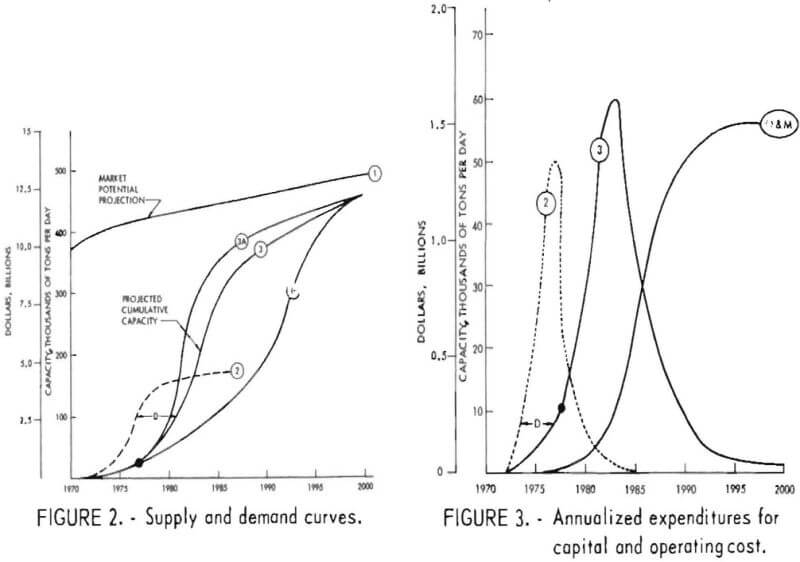
The institutional and political complexities referred to above significantly affect the financing and contractural methods used and are believed by many to cause much of the 5- and 10-year project delay shown graphically in figures 2 and 3.
In figure 2 the maximum processing capacity potential represented by Standard Metropolitan Statistical Areas (SMSA’s) of 100,000 people or larger is shown. The dollar scale on the left side is based on the $26,800 average cost per ton of daily capacity indicated above. Curve 2 is based on a survey conducted by Raytheon Service Co. in 1975-76 in which over 150 out of 157 SMSA’s of 250,000 people or more were contacted. At that time over half of those contacted indicated plans to initiate resource recovery systems. Curves 3A and 3B outline a zone within which the path of resource recovery capacity is likely to move. Curve 3 shows the early, slow development of capacity that has occurred to the present. The dot on curve 3 represents the 24,000 tons of capacity represented by current projects. Figure 3 annualizes the cumulative data shown in figure 2. Also shown are the projected annual operating and maintenance costs that would result as the system developed in accordance with the frequency shown on curve 3 becomes operational. Of particular interest is the observation that sustained annual O&M expenditure levels of about the same order of magnitude as expected for peak annual expenditures for system acquisition can be anticipated.
It will be interesting to observe development of the resource recovery system business over the next 5 to 10 years, as operating experience accumulates for the several system types referred to above, under varying funding and contractual arrangements.
Solid Waste Energy Recovery System – Waste Energy Recovery Returns Profit
In October 1976, the City of Albany and the State of New York signed a unique 20-year agreement which will solve the problems of solid waste disposal for the city, and stabilize the rising costs of energy for the State office building complex. Under the agreement, the city will process municipal solid waste to produce a fuel to be purchased by the New York State Office of General Services (OGS), and OGS will construct two new refuse-fired boilers to generate steam to heat and cool the Empire State Plaza and other major State buildings located in downtown Albany. The refuse-derived fuel (RDF) product will be sold to the State at a 20-pct cost savings over the market price for No. 6 fuel oil, the current fuel being used. The contract represents an exceptional declaration of cooperation between municipal and State governments on a project that will result in significant savings for all parties.
When the City of Albany first considered the concept of recovering energy and materials from solid waste as an alternative to landfilling, the following design objectives were established:
- To provide an environmentally acceptable, economical alternative to landfilling.
- To economically produce a competitively marketable fuel or energy product.
- To economically recover all recyclable materials for which there is a market.
- To design a system which had no environmentally undesirable waste or byproducts.
- To use only existing or proven technology in the system.
The system, the Albany-New York Solid Waste Energy Recovery System (ANSWERS), is a regional resource recovery program designed to initially process 750 tons per day of municipal solid waste, producing a fuel for steam generation and recovering all recyclable materials. It developed out of an imperative need to find an alternative to sanitary landfilling in the City of Albany. A municipal commitment to preserve the quality of the physical environment and conserve energy together with a fuel customer willing to use a processed refuse fuel to save energy and reduce costs have been the key ingredients in the development of this project. The amount of fuel needed by the State is approximately equivalent to the amount of RDF the city can process on a day-to-day basis. Most significantly, ANSWERS has been designed to be a profit making venture and is, therefore, an economically attractive program for all those concerned.
The project is well under construction, commitments for delivery and purchase of fuel have been signed, bid prices have been within the budget, and startup is scheduled for May 1980.
Direct Incineration of Municipal Solid Waste Versus Separation of Combustibles
This study was conducted as part of the U.S. Department of the Interior, Bureau of Mines program to develop technology for increasing the Nation’s mineral supply through recovery of valuable constituents from currently discarded waste materials. Municipal solid waste (MSW), although presently a major disposal problem, represents a significant potential source of metals, glass, and combustible materials. The technical and economic feasibility of physically separating MSW for metal, glass, and combustible fraction recovery has been successfully demonstrated in the Bureau of Mines 5-ton-per-hour urban refuse pilot plant.
The combustible fraction is approximately 70 wt-pct of the MSW and is composed of paper, plastics, yard wastes, putrescibles, wood fabric (table 1), and other minor components that are separated from the metals, glass, and other non-combustibles during the operation of the pilot plant. This fraction can be a valuable supplement to coal in the generation of heat and electricity. Evaluation of the combustible fraction as a fuel supplement is an essential part of the research leading to total resource recovery from MSW. Although the combustibles are a valuable source of energy, as demonstrated by a Bureau of Mines evaluation described in BuMines Report of Investigations 8044, some resistance to the application of MSW as a fuel supplement has occurred because of speculation concerning trace metal emissions to the atmosphere when the combustible fraction of MSW is burned together with coal. However, the limited data available on combustion of MSW were derived from municipal incinerators where the MSW was not separated into combustible and noncombustible fractions prior to incineration.
If the total MSW is burned, as in municipal incinerators, the emitted metals may come from one or both of the two major components of MSW—the combustible fraction (paper, cardboard, plastics, fabrics, etc.) and/or the non-combustible fraction (ferrous metals, nonferrous metals, glass, ceramics, etc.). The purpose of this Bureau of Mines study was to determine if separation of the combustibles from the total MSW will result in lower concentrations in the fuel supplement of elements that are objectionable from environmental considerations. Available data from municipal incinerator studies and from analyses of the combustible fractions of MSW, although not originally intended for source identification, are used to identify elements and sources (table 2).

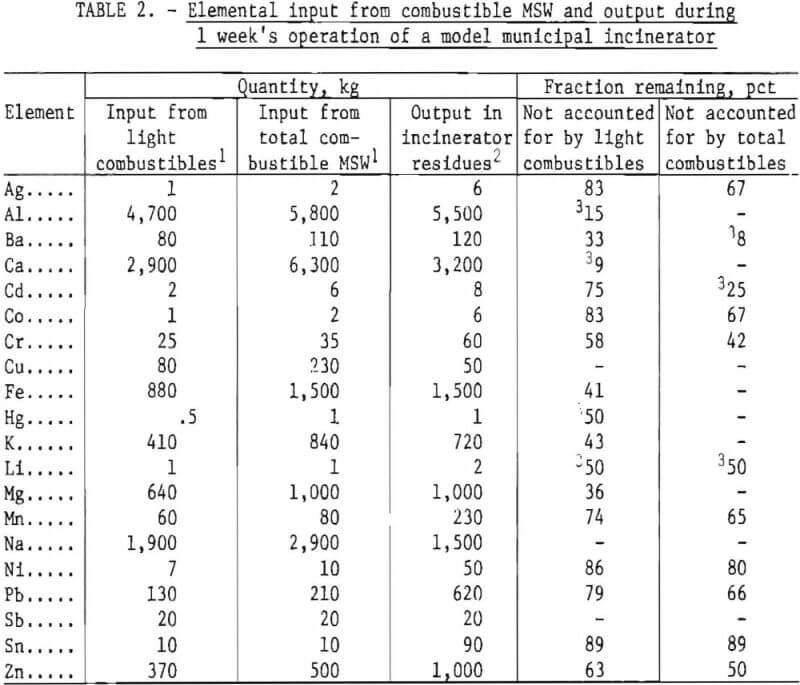
Data on metal concentrations in municipal solid waste and in municipal incinerator residues have been examined to distinguish between combustible and noncombustible sources of the metals that may appear in the residues from the combustion of an MSW-derived fuel. Cadmium, chromium, lead, manganese, silver, tin, and zinc apparently come from the noncombustible components of refuse as well as from the combustibles. The removal of the noncombustible components of municipal solid waste by some recycling operation prior to use of the combustible components for fuel will reduce the concentrations of these seven metals. Also, concentrations of antimony, cobalt, mercury, nickel, and possibly other metals may be reduced by separating the combustibles from the noncombustibles prior to burning. A further reduction of cadmium, copper, and other heavy metals possibly can be realized by not including the heavy combustibles, especially the heavy-gage plastics, in the MSW fuel supplement. The light combustibles from MSW are the refuse-derived fuel source containing the lowest concentrations of trace and minor elements.
Preparing Densified Refuse-Derived Fuel on a Pilot Scale
Refuse-derived fuel (RDF) generally refers to the product of the mechanical (or chemical plus mechanical) processing of municipal solid waste (MSW) to produce a specification fuel. For example, the product of shredding and air classification of MSW is one form of RDF.
By densified refuse-derived fuel (d-RDF) is meant the product of the mechanical compaction of some form of RDF to agglomerated pieces which are sufficiently cohesive to sustain storage and handling. The term “densified” is used in the generic sense to include all manner and forms of compaction, such as extrusion or rolling to produce what are commonly called briquets, pellets, cubettes, etc. Generally, d-RDF would be intended as a fuel for some type of stoker boiler.
Probably the first d-RDF was prepared by F. C. Stirrup in 1959, using at first wood chips and shavings and then municipal refuse. The process consisted of shredding, suspension drying to 8 to 10 pct moisture, and extrusion. In 1960, Stirrup reported the preparation and properties of extruded briquets from German and British refuse on scales up to 6 tons per hour. The process consisted of magnetic separation, shredding (using a Novorotor grinder), drying in a suspension dryer, and extrusion through a Glomera high-pressure briquetting press. A commercial plant for Salford, England, was described but apparently never built.
Stirrup’s d-RDF was in the form of large cyclindrical pieces. No dimensions are given in the early papers, but a single briquet is described as weighing some 2½ pounds.
The next pioneering effort to prepare a specification fuel from MSW in a form that could be burned on a grate was by Hollander and Cunningham . They describe a 30-ton-per-hour plant consisting of shredder, classifier, screens, and cubetter to produce cubettes approximately 1½ by 1½ by 2 inches, formed in a modified John Deere alfalfa cuber. Approximately 40 tons of these cubettes were burned with coal.
This early work did not lead directly to full-scale plants; perhaps it was just “before its time.” Now, however, interest in d-RDF is high, and several organizations are investigating and preparing d-RDF on pilot scales. One plant is doing so on a commercial scale of 60 metric tons per day. In 1976-77, the National Center for Resource Recovery equipped its pilot plant to produce d-RDF for investigative purposes; the Center’s equipment test and evaluation facility has been described.
A 300-ton operating period provided fuel for test burns at the powerhouse of the Men’s Correctional Institution, Hagerstown, Md., through the cooperation of the Department of General Services, State of Maryland. The test burns were conducted by Systems Technology Corp. under contract to the U.S. Environmental Protection Agency, Office of Research and Development, Municipal Environmental Research Laboratory. The results of these experiments will soon be reported. Additional fuel is being prepared and stored for test burns to be conducted in 1978.
Aluminum Scrap Recovered from Full-Scale Municipal Refuse Processing Systems
The growth pattern of the aluminum reclamation (formerly secondary) industry has followed the growth in production and use of primary aluminum. The reclamation industry functions as a supplementary, but very important, source of metal for our economy. Aluminum scrap has comprised 15 to 25 pct of domestic aluminum ingot supply over the last 35 years and has remained at about 22 pct for the last 10 years. Today, from our perspective in the aluminum industry, we look, at recycling as conceptually capable of providing scrap aluminum through two complementary approaches.
To identify the sources of aluminum scrap and the quantity of scrap available from these sources, a study was made by Battelle Columbus Laboratories that would identify the categories of scrap metal on the basis of its original market. The study, published in 1972, was limited to old scrap (that is, metal objects that had been discarded after use). In contrast, new scrap is that scrap recovered directly from manufacturers and fabricators. In 1969, the total quantity of aluminum scrap processed was 1.15 million tons; 200,000 tons of this was old scrap but this was only 13 pct of the available old scrap. By 1975, 334,000 tons of old scrap was recycled; this was an estimated 17 pct of that available. Old scrap usage increased to 416,000 tons in 1976, the last year for which statistics are available.
The advent of resource recovery from municipal refuse has added breadth to the supply of old scrap potentially available to industry. The growing use of aluminum in automobiles indicates that the transportation market, at some point in the future, will provide even more substantial amounts of aluminum scrap and, concurrently, increase the potential market for aluminum scrap.
Recovery of aluminum from municipal refuse is not as simple as ferrous recovery. In today’s systems, aluminum is generally recovered from shredded or similarly processed refuse after a series of concentrating steps that first remove organics, magnetics, and the fine glass and dirt, leaving a concentrate enriched in aluminum that can be further processed using any of several methods.
The first and most widely discussed recovery method is the eddy current separator, of which there are several types now in use. The basis of the eddy current separator is to pass the material to be processed through an electromagnetic field, which for the most part is of a magnitude and frequency that are proprietary to the individual equipment manufacturer and peculiar to his specifications. The electromagnetic field induces eddy currents in any electrical conductor present, which is then repelled by that field.
Another method of aluminum recovery from refuse is the use of dense-media separation, which basically is the flotation of aluminum in an aqueous slurry of magnetite and ferrosilicon, or other dense minerals such as barite or galena. Nonferrous metals from auto shredders are currently being processed by heavy-media separation facilities in about a dozen separate locations. An analog of these dense-media systems, for processing nonferrous metal concentrates from municipal refuse, is being seriously considered by Reynolds.
The characteristics of aluminum scrap recovered from refuse using eddy current separators include contamination with other nonferrous metals or organics such as rags, paper, and film plastic. This may be compensated for by cleaning up the eddy current separator product with an air knife, screens, heavy-media separation, sweat furnace processing, or handpicking.
The eddy current separators currently in use, although similar in principle, can produce differing grades of aluminum scrap. However, an eddy current separator subsystem can be set up to recover whole or partially crushed aluminum cans and large aluminum scrap objects, such as frozen food dishes, while missing most other aluminum scrap, such as crumpled foil.
Aluminum scrap recovered from processed municipal refuse using dense-media systems will generally be under 2 inches in size and include most of the aluminum in refuse, including scrap cans, castings, foil, etc. Analysis of this scrap may also show small amounts of zinc, insulated copper wire, or glass (which often has the same specific gravity as aluminum). Losses of aluminum to the sink fraction in dense-media processing or to the float fraction in the water elutriation step (generally performed prior to the dense-media operation) could be troublesome if the system is not run properly. In contrast, aluminum recovered from nonmagnetic auto shredder residues will often have a much larger average particle size (nominally in the 2- to 6-inch range) owing to the nature of auto shredders and the physical size of aluminum components in autos vis-a-vis the size of aluminum found in refuse.
Analytical data indicates that current state-of-the-art aluminum recovery equipment is capable of recovering a good grade of aluminum scrap. Additional unit operations may be necessary to upgrade the aluminum scrap recovered, depending on the end use required. There is a ready market for the aluminum scrap recovered if it is consistent in assay recovery and chemistry.
Test Results and Application in Commercial Municipal Solid Waste Plants
The costs of handling domestic refuse are becoming increasingly heavy, while the shortage of raw materials is becoming steadily more acute. Bearing in mind that half of domestic refuse consists of paper and that the raw material for paper is in short supply in Sweden, this is something of a paradox. Thus, there is every reason to ripply modern technology to a more efficient use of our raw material resources.
Several factors have thrown recovery techniques into the limelight. According to a large number of forecasts, the shortage of raw materials in Sweden is likely to become increasingly acute in several fields. In particular, a shortage of 1 million tons of paper fiber is predicted by 1980. A large proportion of consumed raw material is available in domestic refuse. Furthermore, the disposal of domestic refuse is expensive and costs increase as environmental demands become more stringent. Costs also increase because existing methods are labor intensive and involve expensive transport operations.
To meet future requirements and obtain an economic utilization of resources, Sweden passed a law in mid-1975 giving the Government full authority to demand that each community with the financial means start a first-stage sorting operation for newspapers and magazines. A preparatory period of 5 years has been allowed prior to application of the new law, so that communities can make necessary preparations and investigations as regards suitable methods.
To a certain extent, and with varying degrees of success, the idea of recovery has long been applied at the source in collection campaigns. Experiments in carrying this out on a more regular and controlled basis have been made in the past and are continuing. However, collection at the source has a number of shortcomings. These include the following:
- The costs of collection and special treatment are fairly high.
- The sorting discipline varies.
- Uncontrolled proportions of materials are collected.
- Unsatisfactory flexibility in adapting the collection to new and varying requirements.
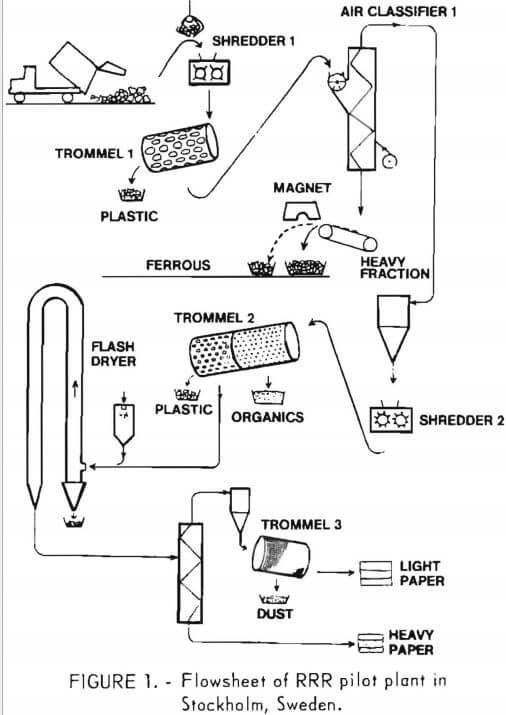
It is, therefore, very important to study alternative solutions employing central treatment plants, in which unsorted refuse can, basically, be fed into one end and usable raw materials discharged from the other (fig. 1).
During recent years, a large number of tests have been carried out and pilot plants operated all over the world. The term “recovery” has become a catchword which is used and abused to justify a wide variety of activities. Recovery is a common term for a number of technical solutions adopted to utilize, partially or entirely, the latent economic value of refuse. Recovery can be divided into three categories:
Direct recovery of substances.—Material recovered becomes new products similar in nature to the original products.
Indirect recovery of substances.—Material recovered may be used for new applications that differ entirely from the original product.
Recovery of the energy content in refuse.—Material recovered is used in combustion, pyrolysis or biochemical decomposition processes, which liberate heat or produce fuel.
The value of the material recovered is obviously a very important factor, since it affects the revenue from the recovery process.
Analysis of the annual operating and capital costs of a recovery plant is equally important, in order to establish profitability at varying levels of revenue from recycled materials. It should be clearly borne in mind that the present, relatively expensive methods of disposal need not necessarily be turned into profit making ventures in the future. As a first stage, it is sufficient to reduce the overall handling costs.
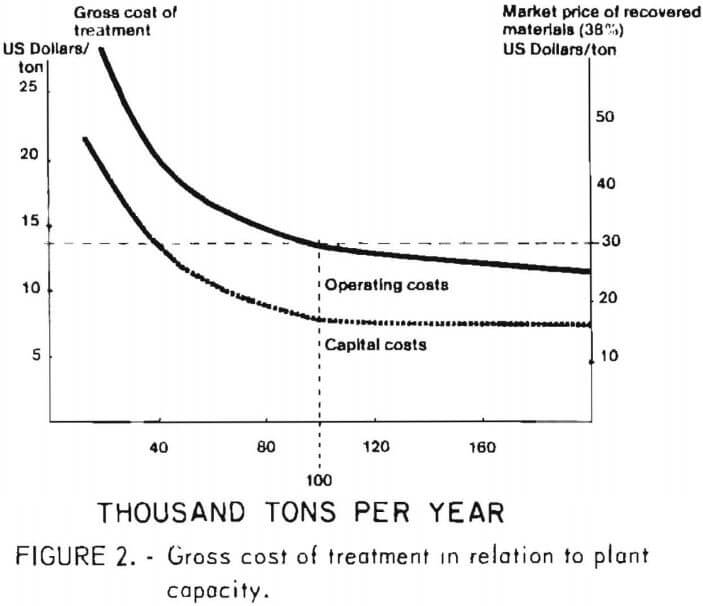 Figure 2 gives an example of the specific costs of processing and the revenue per ton of processed material, after allowances for operating costs and depreciation (10 years for machines, 20 years for buildings, and a 10-pct rate of interest). It relates to a plant with an assumed capacity of 100,000 tons per year. The operating costs, including energy (and heat for drying), maintenance, service and personnel, amount to approximately $5 per ton, whereas the annual capital costs amount to $8 per ton. This means that the average revenue from the material recovered (paper selling at $30 per ton would make the system economically self-supporting.
Figure 2 gives an example of the specific costs of processing and the revenue per ton of processed material, after allowances for operating costs and depreciation (10 years for machines, 20 years for buildings, and a 10-pct rate of interest). It relates to a plant with an assumed capacity of 100,000 tons per year. The operating costs, including energy (and heat for drying), maintenance, service and personnel, amount to approximately $5 per ton, whereas the annual capital costs amount to $8 per ton. This means that the average revenue from the material recovered (paper selling at $30 per ton would make the system economically self-supporting.
Research and development work has led to functional and practical systems for the recovery of materials, thus allowing communities to conserve their resources and at the same time significantly reduce processing costs.
The profitability aspect changes radically with respect to raw materials. What was earlier regarded as useless suddenly gains in value. Municipal solid waste can thus become an important raw material in the production cycle. The recovery of materials will also have an important role to play in the national economy, owing to the energy gains that can be made in refining recycled material as compared with fresh raw material. Moreover, significant environmental gains can be achieved by reducing pollution of earth, air, and water.
Progress in Producing Detinned Steel from Urban Refuse Magnetic Fractions
Two processes have been developed by the Bureau of Mines, U.S. Department of the Interior, for recovering materials of value contained in urban refuse as part of the Bureau’s mission to conserve the Nation’s mineral resources through secondary recovery. One process applies to municipal incinerator residues and the other to raw, unburned refuse. Both are operated regularly on a pilot scale, and details have been published previously.
Current research is concentrated on raw refuse processing, with a lesser, but significant effort on incinerator residues. Intense interest has developed in this country and abroad toward implementing “front-end” separation technology. Several commercial-scale units are already in operation, and others are in various stages of planning or construction. Thus, a resource recovery industry for improved management of urban refuse is developing rapidly.
In the meantime, there is much that can be done on a pilot scale to aid government and private organizations in planning new plants and in determining the recyclability and value of materials reclaimed from refuse. To meet such a need, a raw refuse pilot plant in Edmonston, Md., is operated on a regular basis to (1) generate products for analysis and suitability for recycling, (2) provide technical assistance to government and other organizations to enhance technology transfer, and (3) continue evaluation of the existing process flowsheet and determine what, if any, modifications should be made to accommodate refuse composition variations or to improve product recovery and quality.
Evaluations of products generated in the pilot plant are conducted in-house and by potential consumers to establish recyclability and market acceptance. Standards for ferrous scrap from urban refuse are currently under development in Committee E38 of the American Society for Testing and Materials (ASTM). These include specifications for chemical composition and certain physical requirements for scrap destined for five different industries. Proposed standards under consideration are summarized in table 1. In addition to the chemical and physical requirements shown, the proposed specifications include limitations regarding form (baled or loose) and processing technique (incineration, shredding).
Properly prepared scrap could meet most of the proposed specifications without detinning, but use would be restricted to relatively small quantities to minimize buildup of residual elements. After detinning, however, the scrap can be used with few restrictions and command the higher prices typical of the traditional top grades of scrap. In addition, the tin resource contained in the scrap is recovered as a separate product.
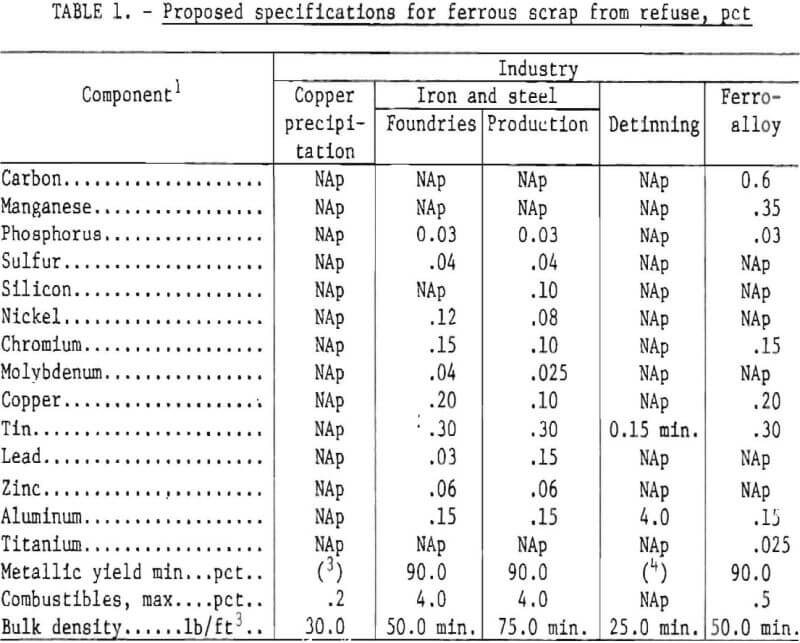
Detailed data on chemical composition are extremely limited for the various commercial grades of steel scrap currently marketed. Table 2 summarizes various scattered data that have been published. Other published data for tin content show 0.025 pct average for all purchased scrap and up to 0.075 pct in iron ore. The chromium coating on tin-free steel cans represents less than 0.01 pct. Even at the higher percentage of 17 pct tin-free cans shown in table 3, chromium in the scrap attributable to this source would be less than 0.002 pct.
The Bureau of Mines, in cooperation with the industry, has evaluated the suitability of ferrous scrap from raw refuse as a raw material for existing detinning operations. Tests ranged from in-house, laboratory-scale detinning to full-scale commercial detinning arranged for and conducted by a commercial detinner. The significant results are summarized as follows:
- It is technically feasible to reduce surface tin on refuse-derived scrap to levels as low as 0.01 pct, on a thoroughly rinsed detinned product.
- On a practical commercial scale, final tin content will include a combination of tin unleached from the surfaces and solder seams, the tin-bearing solution that cannot be completely rinsed off, and tin from solution carried out through absportion in paper, fabric, and wood.
- Unleached tin can be minimized by reshredding the scrap without balling. This achieves greater dislodging of lacquer coatings and rupturing of seams. Shredding also allows for freer flow of the detinning solution and more thorough draining after detinning.
- Solution carryover is minimized by combining air classification and magnetic separation with shredding. This removes combustibles and dirt which absorb caustic solution and reduce metallic yield.
- Preliminary results from 10-ton lots indicate that the primary objective in the commercial-scale test of achieving a tin residual of 0.06 pct maximum was attained.
- Additional phases of the 150-ton test will establish optimum preparation steps for the ferrous scrap from municipal refuse and demonstrate steel quality in production melts.
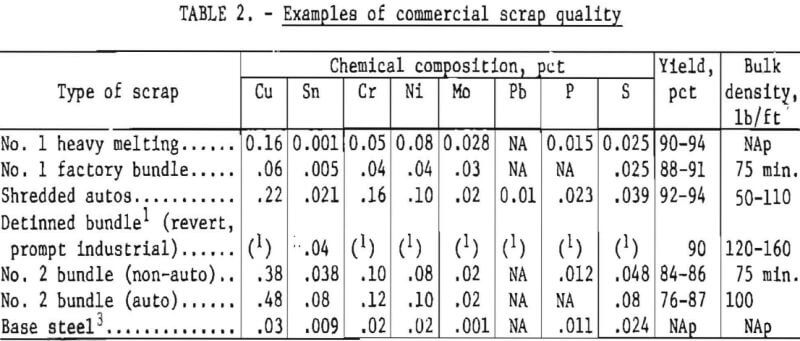
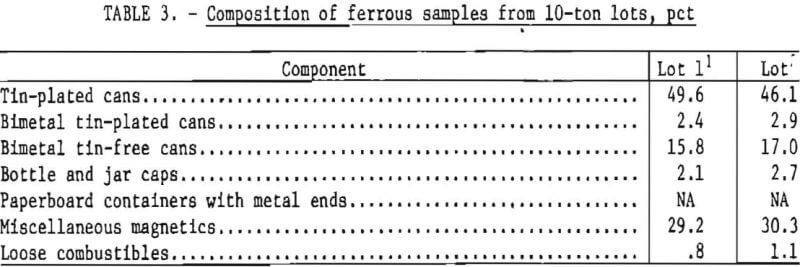
It can be concluded from evaluations to date that ferrous scrap from municipal solid waste can be commercially detinned to an acceptable level with proper scrap preparation. The preparation must remove as much contamination as possible (organics, combustibles, nonferrous metals). The processing must also open whole cans as much as possible to allow the solution to circulate freely and drain upon removal from the tank. Finally, an effective method of processing to accomplish the desired preparation follows: Reshredding the scrap, air classifying to remove light organics and combustibles, then magnetically separating the scrap to eliminate any unwanted heavy nonmagnetic material such as wood and nonferrous metal. This method is similar to that recommended by the Bureau of Mines on its scaled-up flowsheet for raw refuse processing.
Monroe County Resource Recovery Facility
The Monroe County (N.Y.) Resource Recovery Facility (RRF) is designed to process municipal, commercial, and light industrial waste at a rate of approximately 127 metric tons per hour (140 tph), figure 1. Two fully identical primary process lines will extract ferrous metals and a light paper fraction which will be burned as a supplementary fuel in utility boilers for power generation or, alternatively, reclaimed as paper in the future.
The process that will be utilized was developed by Raytheon and is based heavily on experimental work performed by Raytheon and the U.S. Bureau of Mines (USBM) at the USBM Raw Refuse Processing Pilot Plant in Edmonston, Md., under a cooperative agreement for testing and scale-up of resource recovery technology. Similar to operations at the USBM plant, shredding and air classification will be performed in multiple states in the Monroe project. In addition, however, it is planned to utilize a rotary-drum air classifier and nonferrous metal separator developed independently by Raytheon Co. and Iowa Manufacturing Co., a Raytheon subsidiary engaged in the manufacture of heavy process machinery.
Establishing product quality and confidence levels and market development have been key parts of the work performed on this project. This has included testing sample products over a wide range of pilot plant tests, optimizing processing techniques to improve product quality, and testing sample products by potential users in their own operations.
A 20-year agreement has been reached between Monroe County and Rochester Gas & Electric Co. (RG&E) for purchase of the RDF product. This agreement requires RG&E to utilize as much fuel as is possible up to the maximum available from the facility and to pay 100 pct of the net value of coal saved after adjustments for all incremental costs incurred by RG&E for cofiring of RDF with pulverized coal.
Raytheon has negotiated firm agreements for sale of the glass to Owens-Illinois, the aluminum to Reynolds Metals, and the ferrous metals to Vulcan Materials. All these agreements are tied to market indices, have floor prices, and are for 5 years from the date of full commercial operation of the facility.
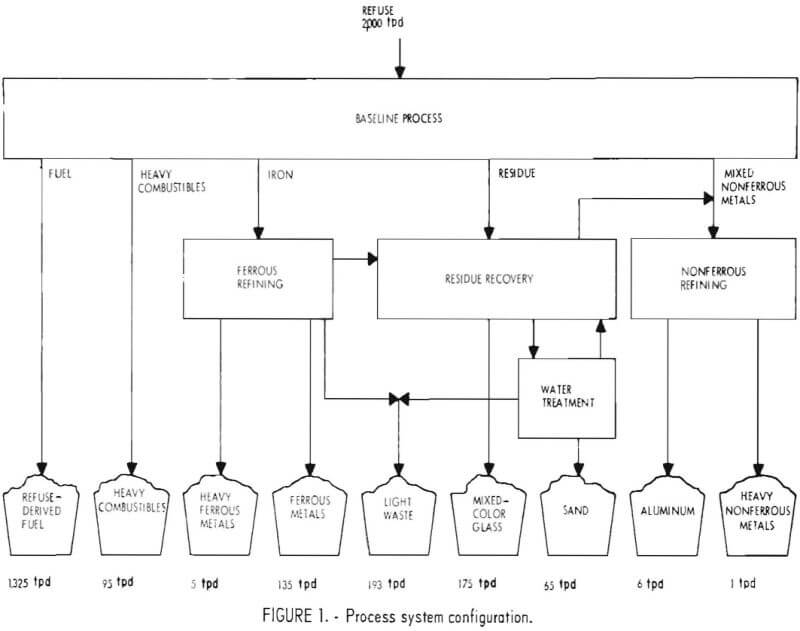
Promising Applications for Municipal Incinerator Residues
Incineration is a principal means of solid waste disposal in many metropolitan areas of the United States. The primary advantage of incineration is that it reduces the volume of incoming solid waste by 80 to 90 pct, thus extending the life of existing landfills. Nevertheless, a residue is produced after burning, which represents from 20 to 40 wt-pct of the original refuse. The residues are a soaking wet mixture of glass, metals, ash, minerals, and combustible matter and must be disposed of in an environmentally acceptable manner.
There are approximately 140 municipal incinerator plants currently in operation throughout the United States. These plants generate a combined total of 5 million tons of incinerator residue annually. Although incinerators are located in 24 States and the District of Columbia, the largest concentration of plants is found in the Northeast, particularly in Connecticut and New York.
Incinerator residue is a heterogeneous material derived from the combustion of municipal refuse. Essentially, municipal refuse is composed of a combustible fraction (paper, food wastes, wood, textiles, yard wastes, etc.) and a noncombustible fraction (metals, glass, ceramics, bricks, rocks, etc). Although the composition and moisture content of refuse does vary during different times of the year and in different parts of the country, the combustible fraction normally represents 60 to 80 wt-pct of the incoming refuse.
The proper combustion of solid waste in municipal incinerator plants is influenced by three basic factors: Time, temperature, and turbulence. The refuse must be exposed to temperatures of 1,600° to 1,800° F long enough for satisfactory combustion. In general, the more the refuse is agitated during burning, the higher the degree of burnout.
Degree of burnout can be defined as the ratio of the incinerated refuse to the combustible fraction of the refuse. It is dependent primarily on the type of incinerator furnace and the grate system used for feeding refuse through the incinerator, although differences in plant operation also affect burnout. For practical purposes, municipal incinerator residues can be broadly classified into three categories, based on degree of burnout, as follows:
- Well-burned-out.—These residues comprise approximately 10 vol-pct and 20 to 30 wt-pct of refuse input.
- Intermediately burned-out.—These residues usually represent approximately 20 vol-pct and 25 to 35 wt-pct of refuse input.
- Poorly burned-out.—These residues comprise about 30 to 40 wt-pct of the refuse input.
Municipal incinerator residues, although heterogeneous in nature, are predictable in their composition and gradation. Past experience and the results of extensive study have shown that these residues are suitable for use in embankments, landfills, subbases, stabilized base courses, and bituminous paving mixtures with a minimal amount of processing. Well-burned or intermediately burned residues are acceptable for such uses. Some aging is recommended for all residues prior to use. Extended aging for 6 to 12 months is needed to improve the characteristics of poorly burned residues.
At present, the use of residue in bituminous paving appears to be the most promising application of this material. Residue use is more highly recommended in base course applications. The residue should be blended on an equal-weight basis with natural aggregate. The addition of hydrated lime is also required to improve asphalt adhesion. Residue paving mixtures can be mixed, spread, and compacted using methods and equipment normally employed in conventional asphalt paving.
Some consideration should also be given to the use of incinerator residue as a synthetic aggregate through heat fusion and in the production of structural brick and mineral wool insulation. The energy requirements and economics associated with each of these applications must be carefully investigated.
Fiber Recovery from Municipal Solid Waste
Depletion of our national forest reserves coupled with an increasing public reluctance to allow the opening of new timber areas to harvesting has resulted in a decreased supply of the basic raw material for pulp and paper production, namely wood. One consequence of this dwindling supply is rising prices for lumber as well as for paper products. In addition to the poor economic consequences, the harvesting of vast regions of timber may pose serious climatological consequences. Evidence is available that supports the contention that destruction of forests has a deleterious effect on the carbon dioxide balance of the atmosphere, with the net effect being the possibility of altering the world climate.
As an alternative to the use of forest lands for securing the raw material for pulp and paper production, the possibility exists for exploiting a heretofore-untapped source of cellulosic fiber; that is, the paper fiber present in solid waste presently being landfilled. In this paper the means of recovering paper fiber from this refuse will be explained. At the same time the properties of handsheets formed from fiber recovered from solid waste will be presented and compared with those of other types of wastepaper. Successful and efficient recovery of fiber from the municipal solid waste stream requires an encompassing management plan ranging from solid waste processing to pulp mill technology. We have examined fiber recovery from the standpoints of refuse collection, mechanical preprocessing, hydropulping, cleaning, water treatment, and determination of recovered pulp properties.
As previously reported by Trezek and Golueke, experiments conducted at the Richmond Field Station of the University of California (Berkeley) have shown that fiber recovery from municipal solid waste is technologically feasible provided that a certain processing sequence is followed. The overall system consists of a dry process followed by a wet process, which includes water.
The main components of the dry processing are (1) a hammermill grinder (rated at 10 tons per hour), (2) a vertical air classifier, (3) a cyclone and air-lock feeder, and (4) a rotary cylindrical screen (trommel). The system is capable of processing up to 4 tons of refuse per hour and typically produces a wastepaper fraction in the range of 40 to 60 wt-pct of the input total. The wastepaper serves as a feedstock for the wet processing system. The percentage of the raw waste that is recovered as wastepaper fraction is dependent upon the type of waste being processed; that is, residential or commercial. The processing sequence has succeeded in reducing the water quality problems associated with the pulping of refuse-derived pulp so that conventional waste-water treatment can be employed. Fiber recovered from residential solid waste exhibits strength characteristics similar to those of 100-pct-deinked newspapers and virgin groundwood. On the other hand, fiber recovered from commercial solid waste possesses slightly greater strength properties, similar to those of a typical newsprint furnish of groundwood and chemical pulp.
The cellulosic content of urban solid waste is considerable. Presently, some 2 million tons of paper per year are landfilled in the San Francisco area alone. Given the technical means as described here for fiber recovery, the solid waste stream can be viewed as a resource to be exploited. It is hoped that this research will stimulate the recovery and utilization of fiber from solid waste. Not only would fiber recovery reduce energy and raw material expenditures within the pulp and paper industry, but the present disposal problem of postconsumer fiber would be greatly reduced or eliminated.
Recovery of Glass from Urban Refuse by Froth Flotation
As part of its research program, the Bureau of Mines, U.S. Department of the Interior, investigates new or improved metallurgical technologies that are needed to help maintain adequate material and metal supplies while conserving natural resources through the recovery of values from secondary resources such as urban refuse. A process was devised and a pilot plant was constructed to reclaim valuable materials from the residues of municipal incinerators. Products from the primary section of the pilot plant include clean ferrous scrap, mixed nonferrous metals, and glass aggregates. A major portion of the current flowsheet is shown in figure 1.
Following development of the incinerator residue system, a companion process was developed and a pilot plant constructed to recover materials from unburned urban refuse. Products reclaimed in this pilot plant include ferrous scrap, aluminum, mixed heavy nonferrous metals, glass aggregates,and combustibles for use as fuel. A major portion of the raw refuse flowsheet is shown in figure 2.
Glass aggregates recovered in both systems contain approximately 10 pct nonglass materials (principally ceramics, brick, and stones), making the products unsuitable for use as cullet in the manufacture of glass containers. To be acceptable for use as cullet, glass recovered from urban waste must meet a rigid set of specifications that has been imposed by the glass container industry. The most critical requirement involves the permissible number of refractory particles that can be tolerated in a specified quantity of cullet. The minus 20- plus 40-mesh fraction of a 1-pound sample of cullet (minus 20- plus 150-mesh), in which there are an estimated 600,000 particles, cannot contain more than 2 refractory particles, and the minus 40- plus 60-mesh fraction cannot contain more than 20 particles.
The specifications include the statement, “for the purpose of evaluating cullet coming from a municipal resource recovery system, these particles will be considered refractory until the glass container manufacturer can certify otherwise.” The particles referred to are foreign particles in a 1-pound sample of cullet that are separated from the glass by heavy liquid at 2.65 specific gravity. Corundum, mullite, zircon, chromite, spinel, sillimanite, andalusite, kyanite, and cassiterite are listed as being refractory in sizes larger than 60 mesh. Ceramic ware, vitreous clay, chinaware, bricks, tile, gravel, and concrete fragments are objectionable since they can result in partially fused inclusions in the finished glass. Metallic aluminum, radio tube parts, spark plug porcelain, chrome ore, or chrome refractory in any amounts are the most objectionable cullet contaminants.
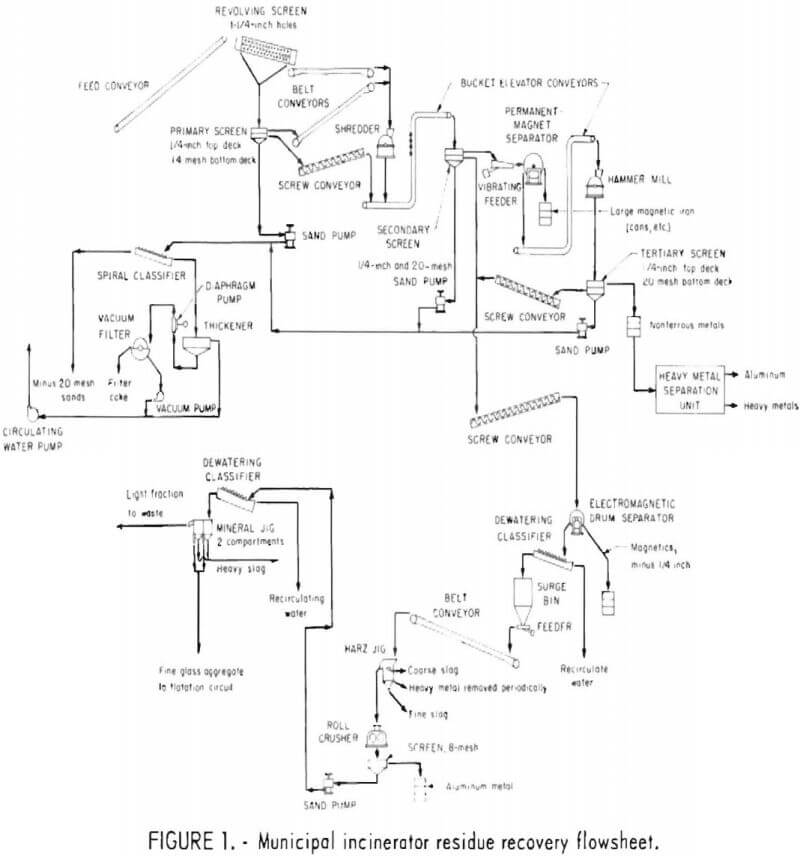
Even though these specifications were not available during the early years of research on incinerator residues, it was evident at that time that the minus 20-mesh aggregate remaining from nonferrous metal recovery operations would not be suitable for use as cullet. Pioneering research was begun to determine whether a clean glass product could be prepared using conventional minerals beneficiation technology, specifically froth flotation. The principal objective at that time was to obtain a marketable product by floating all of the nonglass material away from the glass. Test results gave no real evidence of success for this approach, and the test program was recessed.
In 1970 testing was resumed with the new objective of floating glass away from all nonglass materials. From the start, it was evident that this approach had potential for success, and by mid-1972 results were so encouraging that a decision was made to add a glass flotation section to the pilot plant operations.
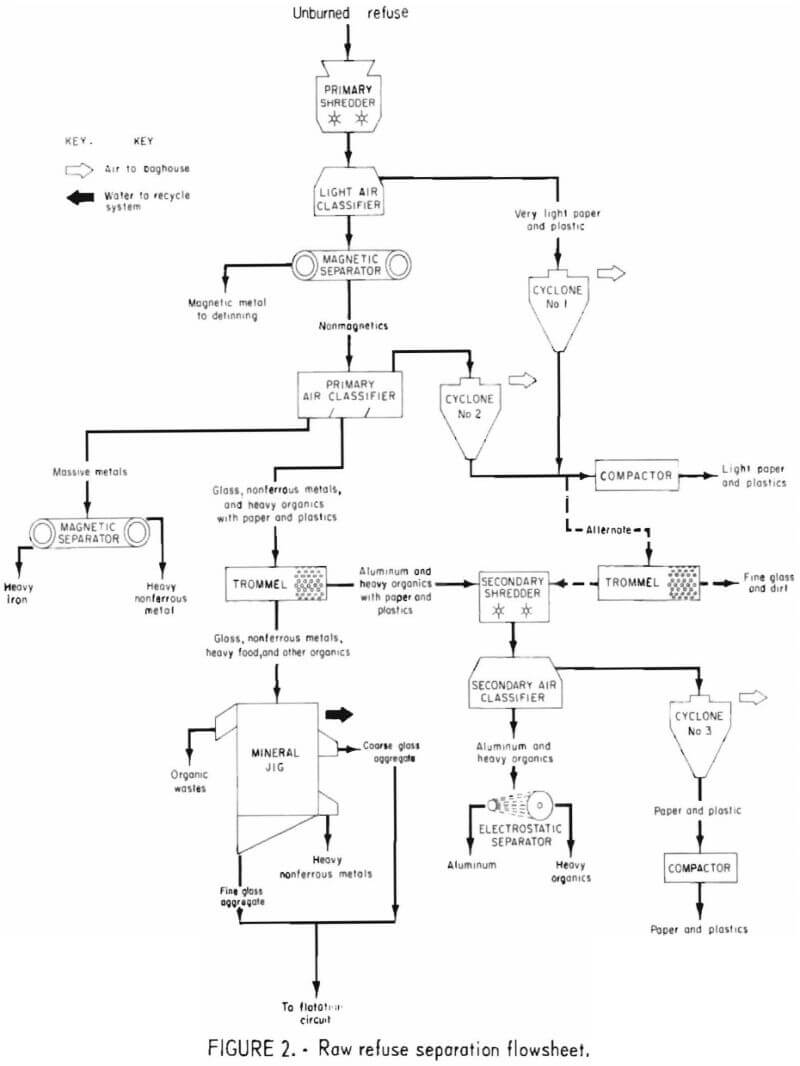
Experience gained from pilot plant operations (fig. 3) makes it unsafe to say that the day-in and day-out production of flotation concentrates will meet the stringent cullet specifications in continuous operations; that is, this is due to the existing lack of precise quality-control methods, the human fallibility of operators, and the inaccuracies that are possible with current methods of product evaluation.
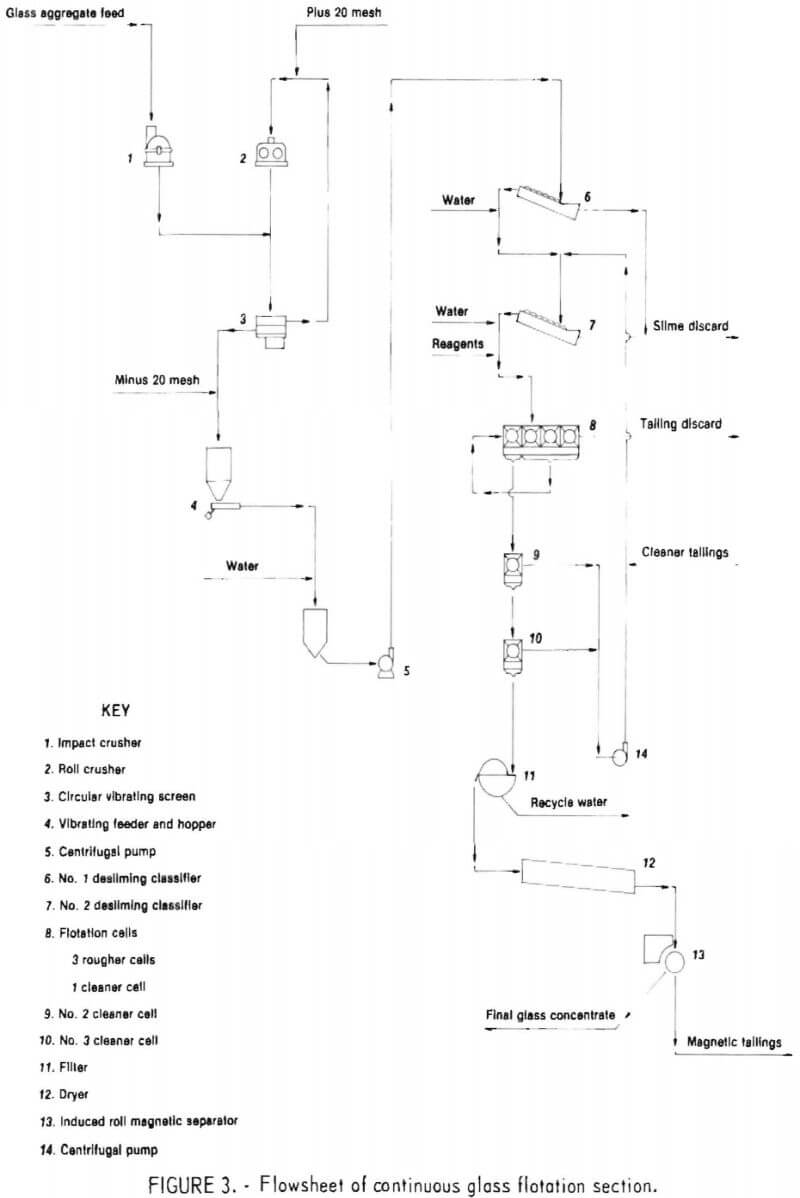
It has been demonstrated by batch and continuous testing, (table 1) that cullet-quality glass products can be recovered from solid waste streams by froth flotation. The technology and equipment involved have been highly developed in the minerals industry. The glass product of this technology is untried commercially, but the fact that three resource recovery plants are now under construction that will use froth flotation in glass recovery systems demonstrate confidence in the emerging resource recovery industry that this product can be used to make new glass containers.

Test Procedures for Determining the Gross Calorific Value of Refuse and Refuse-Derived Fuels by Oxygen Bomb Calorimetry
The recovery and utilization of energy from solid waste have been the subject of much interest since concern is being expressed about our fuel shortages. Fossil fuels are presently being used in powerplant boilers to generate steam for energy purposes. Solid waste is a potential source of fuel that can be utilized in powerplant boilers to generate steam for energy purposes. Therefore, much research is centered around the conversion of solid waste to energy. Before solid waste can be effectively utilized in powerplant boilers, much testing is necessary. The areas of solid waste analysis, ash analysis, emission testing, corrosion testing, and boiler performance are of primary concern.
The American Society of Mechanical Engineers (ASME) Committee for Performance Test Code 33—Large incinerators (PTC-33) has indicated that a need exists to find a more accurate test procedure for the determination of calorific values of refuse and refuse-derived fuels (RDF) that will more accurately represent a corresponding large array of collected raw refuse. If an improved calorific value test procedure is available to the ASME PTC-33 committee, it can offer a mechanism by which public works administrators and private owners can evaluate with greater accuracy and higher confidence than is presently possible whether or not their large incinerators and refuse-fired boilers are in compliance with their contract performance specifications. The E-38 Committee on Resource Recovery of the American Society of Testing and Materials (ASTM) is Interested in establishing refuse-derived fuels (RDF) as an article of commerce. A laboratory procedure giving reproducible results will better equip commercial laboratories to certify accurately the energy content of RDF of various compositions. As an article of commerce, RDF can be bought and sold as a regulated low-sulfur fuel to supplement other fossil fuels. The U.S. Environmental Protection Agency (EPA) and the U.S. Department of Energy (DOE) are collaborating in resource recovery programs to facilitate the development of various waste-to-energy technologies. The need for information on the calorific value of waste streams has been acknowledged by incinerator operators and designers.
The quantity of energy liberated per unit mass of refuse burned (gross calorific value of refuse) can be directly obtained from a bomb calorimetric experiment. The techniques of bomb calorimetry are well characterized. Bomb calorimetry is used extensively in the determination of the calorific value of various fossil fuels. Therefore, it would be extremely advantageous to be able to accurately determine the calorific value of refuse and RDF by bomb calorimetric methods.
However, municipal refuse is far from being an easily characterized homogeneous fuel. Its makeup can vary widely, depending upon many geographical, seasonal, and weather-related factors. This variability will affect both a refuse stream’s potential as a fuel source and its potential as a source of environmental pollution.
The objectives of the research program are threefold:
- Development of test procedures to determine the gross calorific value of refuse and RDF by bomb calorimetric methods.
- Evaluation of sample characteristics by analyzing for moisture, ash, carbon, sulfur, and chlorine.
- Evaluation of the homogeneity and sample preparation requirements for bomb calorimetric experiments utilizing two bomb calorimeters which have capabilities for handling samples that differ by an order of magnitude in mass (that is, 2.5 g and 25 g).
Refuse has five forms: (1) As-received refuse with the “white goods” removed (“white goods” are items such as refrigerators, stoves, and sinks); (2) shredded refuse of 2.5 to 7.5 cm (1 to 3 inch) particle size; (3) shredded refuse with the “heavy fraction” removed (“heavy fraction” is the noncombustibles such as glass and ceramics); (4) refuse pellets; (5) refuse powder. Forms 3, 4, and 5 are considered RDF. The sample preparation required to prepare a bomb calorimetric sample from any of the five forms is such that the bomb calorimetric sample is definitely an RDF. In fact, the preparation of a homogeneous sample for a calorific determination (regardless of the technique to be utilized) is the processing of an RDF of some degree. Therefore, the initial testing performed in this research project started with forms 4 and 5.
Materials used in the program were a standard reference sample of benzoic acid obtained from the National Bureau of Standards, Ultra High Purity-grade oxygen from Matheson Gas Products, Teledyne National RDF, and Combustion Equipment Associate RDF (ECO-II RDF).
Results on a limited number of samples have demonstrated that RDF samples can be processed for bomb calorimetric experiments to produce results with a precision (standard deviation of a measurement) approximately equal to or better than 1 pct. The calorific values determined at three stages of sample preparation showed no overwhelmingly significant differences. For Teledyne National samples, the calorific values slightly increased with increased sample processing, but opposite trends were observed for ECO-II samples. Moreover, the percent deviation (for moisture-and ash-free RDF) based on all three types of samples was 0.802 pct for Teledyne National RDF and 0.424 pct for ECO-II RDF. Percent deviations between two types of either Teledyne or ECO-II RDF’s ranged from 0.21 to 0.94 pct.
Our standard deviations of a measurement are much less than one would initially expect for something as nonhomogeneous as refuse. This was achieved by using the amount of combustion residue of each experiment to calculate an MAF calorific value rather than an average ash value. For some RDF samples the ash values are not constant. Noncombustibles must “stick” to RDF particles and are therefore not uniformly distributed throughout the RDF samples. Therefore, a more precise ash-free heating value can be calculated using the amount of ash contained in each combustion sample.
Coals of various ranks have typical moisture-and ash-free (MAF) gross heating values (2-3) ranging from 34.89 to 25.59 MJ kg-1 (15,000 to 11,000 Btu lb-1). Our MAF-RDF results ranged from 25.20 to 21.93 MJ kg-1 (10,835 to 9,427 Btu lb-1). Our results are based upon two 20-kg (44-pound) field samples of RDF, which automatically makes it impossible to evaluate whether our results are typical of the RDF’s produced by either manufacturer. However, RDF’s calorific value makes it definitely a viable competitor of some low-rank lignites. Also bituminous coals typically demand a greater degree of fineness than low rank coals to achieve complete carbon burnout. The necessary degree of fineness for RDF’s may even be less (that is, larger particles) than that for the low-rank coals.
All fuels contain mineral matter that goes through varying stages of decomposition and recomposition in the combustion process. It all ends up either as bottom ash or fly ash. Coal may have ash contents of the order of 10 pct, compared with the 12 pct values we experienced with RDF. However, ash fusibility data re necessary to properly evaluate the ash problem presented by refuse and RDF.
Operating Economics of the City of Ames Resource Recovery System
The Ames, Iowa, resource recovery system, which processed an average of 186 tons per working day in 1977, is shown in schematic form in figure 1. The refuse is processed by two stages of shredding, magnetic removal of ferrous metals, air density separation, and nonferrous metals separation. The metals are sold, and the refuse fuel is stored, then fired as a supplement to coal in the city-owned powerplant. Details of the system’s equipment have been presented in other references. Startup and equipment shakedown began in September 1975.
After startup, the system’s design engineering firm (Henningson, Durham & Richardson) began an operations monitoring program. Information was scarce during the first few months of operation, because the city’s accounting system for the new municipal entity had not yet been finalized. As more information became available, the calculations and reporting became more complex. A computer-based management information system (MIS) has therefore been developed to aid in operations monitoring. Operating data are entered (or changed) and reports are generated with an interactive computer program which requests the required information with a series of questions in English. This feature allows for use of the MIS by persons not familiar with the programing, or even by persons unfamiliar with computers.
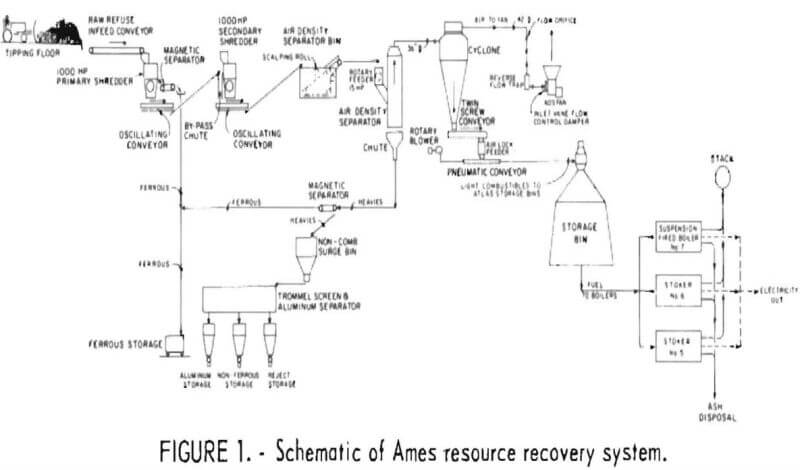
The following is a discussion of results obtained after running the unit for the year 1977. Data were obtained through the use of the MIS.
Materials Balance
Over 48,000 tons of solid waste was processed by the system in 1977, which is an average of about 4,000 tons per month, or 186 tons per working day. About 3,000 tons of ferrous metals (6.2 pct of total waste stream) were sold at an average of $31.5 per net ton before transportation charges during the year. Almost 84 pct of the total was converted to fuel with an average value of about $1.15 per million Btu. Smaller amounts of other materials were recovered.
Energy Balance
About 2.8 million kwhr was consumed by processing, storing, and conveying the refuse (an average of about 60 kwhr/ton processed), while about 19.3 million kwhr was produced from burning the prepared fuel. This represents an average out-in ratio of 7:1 ( a low of 4:1 and a high of 10:1).
Trommel Processing of Municipal Solid Waste Prior to Shredding
Shredding has been traditionally regarded as the first step in processing municipal solid waste (MSW) for recovery of materials and energy. The facilities constructed in the last decade have generally taken this approach. The functions the shredder performs are two: (1) Reduction of material to a more uniform particle size, and (2) liberation of composites or entrapped materials.
There are, however, drawbacks to shredding. First, shredders have high operating and maintenance costs. These are primarily electrical energy consumption and the labor, energy, and materials associated with hammer retipping, balancing, and replacement. Further, shredding has deleterious effects upon subsequent resource recovery processes. Following shredding, the most common processing step is air classification. The idealized function of this is to produce two fractions: (1) An organic combustible fraction, and (2) an inorganic noncombustible fraction which can be processed for materials recovery. If the ideal were achieved, many of our current problems in resource recovery would be eliminated. However, the separation is far from ideal. Inorganic material reports with the organic fraction. The primary offender is glass and other fine-particle material. Some fine material is inherent in the solid waste; however, the greatest percentage is generated by the shredding process. The National Center for Resource Recovery has estimated that as much as 80 pct of the glass in MSW entering a shredder will be pulverized so as to fly in the air classifier. This, plus the fines inherent in MSW and the 8 to 10 pct ash of paper and wood products, results in a refuse-derived fuel (RDF) with an ash of 25 pct or better. In addition, the glass that misreports in the air classifier is lost to recovery if glass recovery is to be attempted.
To overcome the disadvantages discussed above, the design of the Recovery 1 facility in New Orleans—a partnership among the National Center for Resource Recovery, the City of New Orleans, and Waste Management, Inc.—incorporated a trommel screen. This device, placed prior to the shredder, open the refuse bags, both paper and plastic, breaks glass and other friable materials, and removes from the MSW those items that are smaller than the nominal screen size. In New Orleans, this is 4 inches.
From the data developed by the testing in New Orleans, it can be concluded that the trommel achieves two of its design goals. It concentrates metals and glass for material recovery, and it enhances the quality of the potential refuse-derived fuel fraction. While there is a loss of potential fuel to the trommel underflow, it would appear that this would be acceptable in the many situations where lowering of the ash content is currently the primary concern. Further, the organics in the underflow are not lost and can be recovered by subsequent processing of the underflow for materials recovery. In conclusion, the trommel appears to be a valuable new tool in the effort to recover resources from municipal solid waste.
Upgrading Products from Raw Refuse for Marketing
Research on recycling urban solid wastes in Spain is being performed by the Empresa Nacional Adaro de Investigaciones Mineras, S.A. (ENADIMSA) in Madrid. This firm belongs to the Instituto Nacional de Industria (INI), which is a division of the Ministry of Industry of Spain. ENADIMSA is mainly concerned with applied research in geology, hydrogeology, mining, and mineral dressing problems, as well as in environmental control, especially in regard to the recovery of raw materials from urban and industrial wastes.
ENADIMSA’s research on raw refuse was started 5 years ago, under the Plan for Scientific and Technical Cooperation between Spain and the United States. Very effective aid was obtained from the U.S. Department of the Interior, Bureau of Mines, Avondale (Md.) Metallurgy Research Center. The latter provided all the information and experience it had accumulated at that time.
Research programs developed by ENADIMSA since that time have been conducted along the following three different lines of technology:
- Rough classification processes, figure 1.
- Upgrading operations, figure 2.
- Utilization of organic materials, figure 3.
The work done on rough classification processes has been described in papers presented at the Fourth and Fifth Mineral Waste Utilization Symposiums and will not be further discussed here. The present paper describes details of the development of the next two lines of technology which complement the basic flowsheet previously exhibited for the rough classification process.
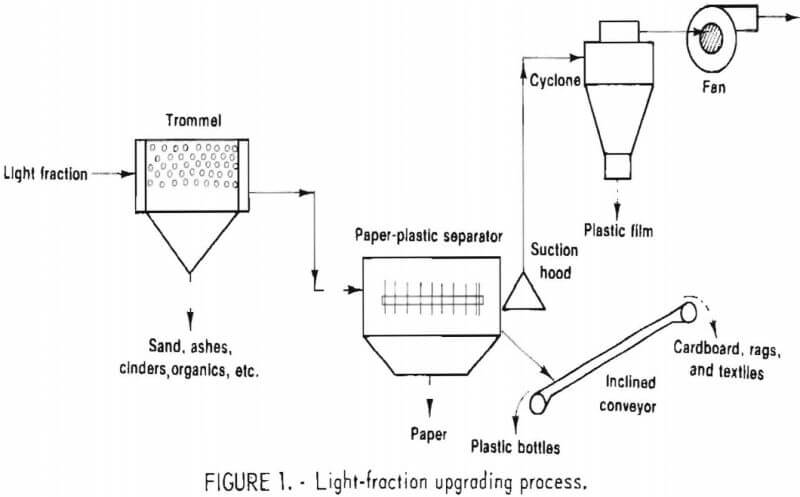
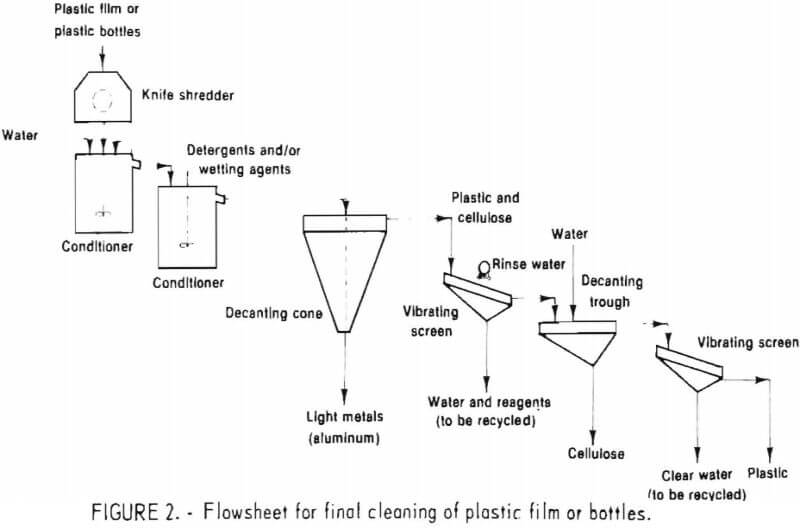
Products emerging from the rough classification process described in references 1 and 2 can be utilized commercially. However, the market prices for such products are very low. On the other hand, the price may be increased by means of simple upgrading or finishing operations, which is justification for the needed research in this area. This is illustrated by the following process developments:
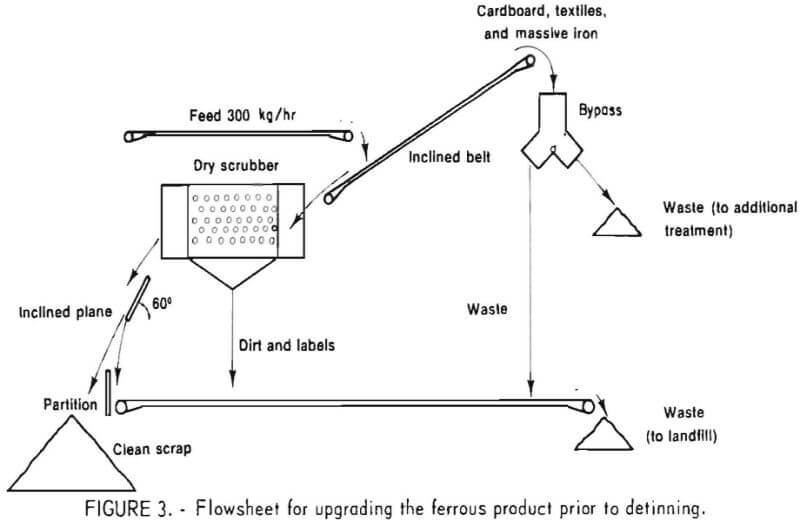
- Paper from plastic separation.
- Plastic upgrading.
- Upgrading magnetic scrap.
The enormous quantities of food wastes, which may amount to as much as 60 pct of the total refuse in Spain, support the need for research on the utilization of organic materials. This involves new research in the following specific areas:
- Energy production:
a. Bioconversion (anaerobic biodegradation).
b. Solid refuse-derived fuel (RDF) production. - Animal food production: Protein sources.
Most of the work, on utilization of organic materials is still in a preliminary stage.
Utilizing Processed Incinerator Residue as Cover Material for Sanitary Landfill
The City of Philadelphia has for more than 50 years employed incineration in its solid waste management program to reduce the volume of waste materials prior to land disposal. In recent years, the incinerator program has involved two modern combustion facilities, employing the best available technology and fitted with electrostatic precipitators for air pollution control.
Historically, the residuals resulting from these two facilities have been disposed of at land sites primarily within the City of Philadelphia. Continued use of sites within the city grows increasingly unlikely since such sites have all but disappeared. In addition, plans underway by the city envision at least one, if not more, energy recovery facilities utilizing solid waste as fuel. The end products of such combustion processes would be additional residue materials requiring land disposal. With diminishing acreages of disposal areas, it is clear that the energy plants of the future may be jeopardized by a lack of residue-disposal capacity.
The residue quantity from the two incinerator facilities is approximately 400 tons per day. At the city’s Northwest Incinerator facility, residue from both plants was stockpiled for periods of up to one year prior to removal to land disposal sites. The residue was magnetically picked by a salvage operator under contract to the city to reclaim ferrous metal. It was felt that the combination of long-term storage and metal recovery altered the basic characteristics of this material—providing the opportunity for it to be considered as cover in sanitary landfill operations.
In order to achieve the purpose of this program, the parties—
- Placed 400 tons per day of incinerator residue in a suitable holding area at the Northwest Incinerator facility for a period of 6 to 8 weeks.
- Following suitable processing, removed this stored material from the holding area at a rate up to 300 tons per day to the Montgomery County Sanitary Landfill Site. The movement of this residue material utilized city personnel and vehicles initially. Currently, a single contractor processes and hauls the material to Montgomery County.
- Utilized this material as daily and intermediate cover for the refuse disposed of in the Montgomery County Sanitary Landfill Site in a manner intended to duplicate as closely as possible the daily operating procedures currently employed at this disposal site. Some of the material was used for internal landfill roads and for testing as a final cover substitute.
- Monitored, tested, and evaluated the effects of the use of this residue as cover on the landfill operations, including observations of the residue as cover. Techniques were utilized that were designed to determine if the residue satisfies the physical requirements of suitability for cover, wrokability, prevention of rodents and other vectors, and containment of combustion within a cell.
The performance of the processed residue in its role as earth replacement for cover has been observed, monitored, and evaluated continuously since the inception of the shipments. Although more specific detailed evaluations are underway by Villanova University and the Department of Environmental Resources, the following observations can be made regarding criteria for suitable landfill cover:
- Workability. Landfill operating personnel verify independent observations that the processed residue has comparable workability to loose soil. It was spreadable and compactible, and covered the refuse adequately to meet State requirements. A particularly dramatic benefit of the material was its performance under wet weather conditions. According to Villanova, the residue did not soften when wet, owing to its granular, relatively cohesionless nature. This fact extended the landfill’s operations under adverse conditions.
- Prevention of rodents and other vectors. No evidence of rodents or other vectors was observed as a result of the use of processed residue as soil cover replacement for the landfill. Additional monitoring of this fact is being conducted by county and State vector personnel. The material did not dry and crack so as to allow development of emergence of vectors.
- Containment of combustion in a cell. No fires have occurred during the demonstration period,and experienced observers foresee no increased chance of uncontrolled fire based on this material as compared to soil.
- Control of blowing paper. The processed residue performed the same role as normal earth cover in preventing the emergence of paper and litter through the cover. Had the material settled through the refuse due to an overly granular nature, problems of blowing paper would have occurred.
- Suitability for revegetation. To evaluate the revegetative capabilities of the processed residue, a special testing program was established at the landfill and in the greenhouse at the consultant’s labs. The primary purpose of the first tests was focused on the ability of the material to support and maintain grass growth. The processed residue combined with sewage sludge produced 3 to 5 inches of grass in thick quantities within 2 months. This growth reemerged in March and April 1978.
For a landfill that must use imported over, such as the one operated by Montgomery County, the possibility of cost savings can become reality. For example, the county pays $1.65 per cubic yard for its cover. At the projected rate of 300 tons per day, the value of the processed material can be as much as $155,000 per year. At the average rate of refuse receipts at the landfill, this would be equivalent to approximately $1 per ton.
The City of Philadelphia benefits by eliminating the haul of the material to current New Jersey landfills. The mileage saved is about 30 miles. Even if the haul were the same to an alternate landfill, the city could project a value equal to the price of disposal in comparable Pennsylvania landfills. For example, based on the Montgomery County disposal price of $7 per ton, the processed material turns a $650,000 liability into an equally valuable asset.
Solid Waste Characterization for Resource Recovery Design
Solid waste characterization, as defined here, refers to the estimation of the quantity and composition of solid waste available to a resource recovery system. Because exact information cannot be obtained, an acceptable level of estimate accuracy must first be identified in order to define the scope of the waste survey. Investors, designers, and markets may all specify an accuracy requirement; it is then left to the survey planners to decide how that level of accuracy can best be obtained.
Accuracy versus Precision.—The terms “accuracy” and “precision” are often used interchangeably but have entirely different meanings when describing a waste quantity or composition estimate. Accuracy refers to the closeness of an estimated value to the true value of the parameter being measured; precision refers to the repeatability of the measurements. To illustrate the subtle but important difference, imagine that an engineer is responsible for estimating the daily waste generation rate in City X. A review of the literature results in 10 per capita waste generation estimates that are close to one another in magnitude. Concurrently, random selection of 10 collection routes with known daily waste loading and population results in 10 widely scattered per capita estimates. The 10 literature estimates provide a more precise estimate of waste generation, while the 10 field measurements will likely provide a more accurate estimate of the true waste generation rate (assuming the route selection was truly random). In fact, only a well-designed field survey can provide an a priori estimate of the expected accuracy of the results.
Precision (and accuracy) is expressed as a percentage interval about the estimated mean (for example, 10 pct). Because the size of the interval will be a function of sample number, accuracy requirements will actually dictate the level of effort necessary to properly perform the survey. This requirement is usually comprised, if not totally neglected, when the waste characterization budget is insufficient. As a result, past practice in waste characterization would not be expected to reflect the actual needs of resource recovery planners.
Waste Characterization Accuracy Requirements.—To determine the waste characterization accuracy required by the resource recovery community, quantitative accuracy requirements were solicited from designers and secondary material buyers. The sensitivity of system economics to inaccurate waste characterization was assessed through computer simulation.
Design Requirements.—Design accuracy requirements are specific to each unit operation in solid waste processing (that is, receiving and storage, handling, shredding, classification, screening, magnetic separation, and thermal processing). These requirements were provided by the E-38 Committee of the American Society for Testing and Materials (ASTM) and are summarised in table 1. Supplemental data on design accuracy requirements were also obtained from (1) size-reduction equipment designers and operators, (2) incinerator operators, and (3) consultants experienced in resource recovery design.
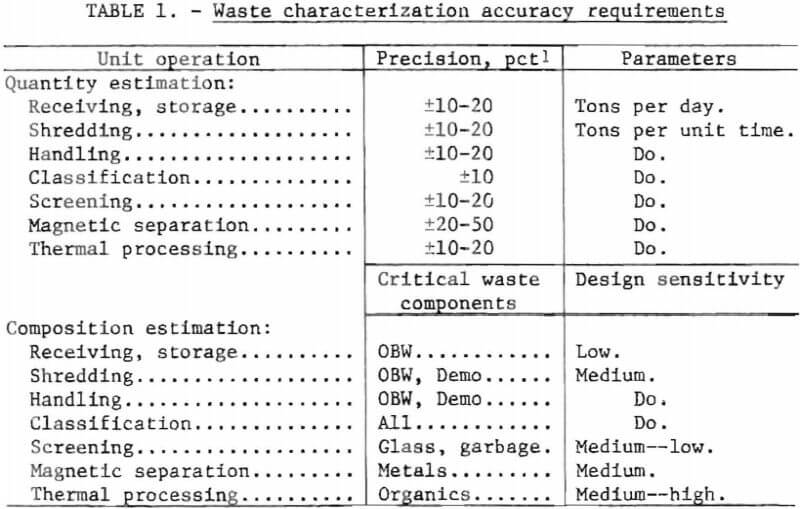
The findings indicate that both quantity and composition accuracy requirements for resource recovery design vary with each unit operation. ASTM reported accuracy requirements for quantity estimation that were as stringent as ±10 pct. Requirements for composition estimation appeared less critical and were based on the identification of specific components in the waste stream. Each unit operation tended to be sensitive to one or more components. Less stringent design accuracy requirements were reported by processing designers, manufacturers, facility operators, and consultants. These requirements were generally based on the literature and incorporated some degree of conservative design.
The diversity of responses indicates that design accuracy requirements have been specific to each designer. No industry standards exists. The ±10 to 20 pct precision figure was subsequently used as a target specification for developing the statistical survey design but should be interpreted only as a worst case specification for experimental work.
Marketing Requirements.—Accuracy requirements are an important consideration in the marketing of materials and energy recovered from solid waste. High-technology systems may generate more material than low-technology systems in the same waste shed. To develop the stable market conditions necessary for this larger amount of material, investors require long-term contracts for the sale of recovered materials. Before signing such contracts, buyers will often require that the quantity and quality of material to be sold be specified with a certain degree of accuracy. Price is sometimes determined based on expected volume, and penalties for inaccurate estimation have been incorporated in some contracts.
Reporting of Results.—The reporting format and level of detail desired may be specified by the ultimate uses of the survey data. If not, the results should be reported in summary form with a brief review of the procedure used (assumptions, data sources, etc.). The following general guidelines of what not to report are also offered:
- Do not report quantity or composition data by route or hauler, if possible, as many haulers feel this information is confidential.
- Do not report the results of the survey without some description of the survey procedure used. Others may use the data later and should know its limitations.
- Do not report the data without the computed confidence intervals; interpretation of the estimate should be left to the user of these estimates.
- When using published data in place of part or all of the survey, reference it as such and do not publish it again as “local” data. This only serves to perpetuate data that may be outdated or of questionable origin.
The characterization of solid waste is typically a low-priority item in resource recovery design. Designers and markets are beginning to develop more stringent accuracy requirements, thereby necessitating the use of field surveys to satisfy these requirements. Through statistical design, these surveys can be performed for a reasonable cost. Field surveys should be more widely used in place of published estimates.
Impact—Paper Recycling Versus Supplemental Fuel
Although at present there are only a few scattered energy plants that use municipal solid waste as a supplementary fuel, it appears that the trend is upward as landfill sites become increasingly scarce. Certainly this use of trash is ecologically sound. However, there are increasing signs of concern over the possible loss of waste paper from the historical recycling pattern into paperboard, construction paper, and the board industry. In addition, the relatively new industry of recycling old newspapers back into newsprint can be affected because it is largely dependent upon the metropolitan areas for its raw material and these areas are the most likely to use trash for supplemental fuel.
Numerous studies indicate that the United States may be faced with a wood shortage anywhere from 1990 to 2025. Certainly, it is becoming more difficult to increase the wood supply in view of future legislation, court decisions, emotions, and environmental concerns, real or imagined. Thus, it seems wise at this time to consider the effects of burning of cellulose fiber and building long-life systems for its destruction as fiber.
While it is uncertain at this time to project the increasing demand for waste paper very far into the future because of the complicated economic problems of reuse, now is the time to give the problems considerable thought.
We seem to be faced with two major questions. Do we restrict the collection of waste paper in our municipalities for recycling back into the paperboard industry or reserve it for steam generation, or do we use steam generation as a secondary system to consume waste paper where the supply exceeds the demand?
In the first case, this situation has occurred in the Saugus, Mass., area wherein all municipal solid waste is reserved by municipal ordinances for steam generation. This action has upset the local sources of supply of old newspapers and old corrugated cartons normally used by the local board mills. It appears to have had serious economic consequences. In the second case, it is the normal historical pattern of disposal or recycling. As waste paper exceeds demand, more is landfilled or incinerated.
Thus, we come to another important question—how much effect does increased consumption of waste paper have on the calorific value of municipal solid waste? There is little change in Btu values under the various assumed conditions under study. On the dry basis, 8,000 Btu per pound seems to be a fair value. On the wet basis, 24.5 pct moisture, which is the basis of feeding the steam generators, the fair heat value is 6,000 Btu. No consideration has been given to some noncombustible carryover in a shredding and air classification. The ash content is likely to vary in the various components. So, 5,000 Btu as used in many estimates is a conservative value.
A potential decline of waste paper in municipal solid waste has several environmental consequences—less collected tonnage by municipal authorities and more concentration of noncombustibles at a processing plant. It seems to justify separation operations because of sizable volume of glass and metals.
If cullet can be sorted by color as research indicates, a market can be developed for glass. Therefore, so far as the facts are known, the collection of waste paper for recycling will not change the supplemental fuel heat value.
It is, therefore, unnecessary for municipal authorities to impose restrictions on the collection of waste paper for recycling unless the decline in volume makes steam generation unwarranted, a condition that seems unlikely. Lowering the volume of waste paper by various collection systems will actually be beneficial by lowering trash collection costs for municipalities.
As important as reduction in collection of trash is to a municipality in reducing costs, a major reduction by salvage at the curb level could reduce the quantity to the point where it could affect the profitability of a plant designed to use trash as a primary fuel. It would seem wise therefore to consider trash as a secondary fuel because it is unlikely that minimum quantities of trash would balance with minimum steam or energy demands.
New Reclaiming Process for Waste Papers
At present Japanese paper production amounts to 15.4 million tons per year, and 6.3 million tons of them are recovered and recycled as waste paper. The 38 pct reclaiming rate is twice as high as that of the United States and will probably increase to 50 pct in the near future owing to a lack of timber resources.
From the standpoint of material and energy savings, recently there have been strong demands for the development of new processing techniques for waste papers. Conventional reclaiming processes for waste papers have many problems; for example, too high consumptions of water and electricity, clarification of waste water, disposal of sludge produced from the thickener, and high operation costs. Research was conducted on the processing of printed waste papers which contain large quantities of ink and clay. As a result, a new reclaiming process was developed.
The process itself has a number of advantages and has been greatly simplified and improved. It also yields great savings in terms of overall operating costs. Patent applications for this new system have been made in Japan and abroad. Printed waste papers are processed in the following steps: Disintegration, ink flotation, fiber recovery from deinked pulp, and clay flotation in waste water.
In disintegration, waste papers are fed into a hydropulper where they are pulpified and contaminants are removed from the paper fiber by using alkali and sodium silicate to promote defiberization. The disintegrated pulp is fed into an ink flotation cell where small air bubbles are generated uniformly from the cell bottom where air is blown into specially equipped porous bodies. Ink flotation is promoted by adding surface-active agents, such as petroleum group agents, oleic acid, and pine oil. In the next step, fibers are recovered as oversize from the deinked pulp by using a vibrating screen. White waste water through the screen containing large amounts of fine clay is supplied to a clay flotation tower. Then the flocs readily float, adhering to the air bubbles. The vertical flotation cell is also available for clay flotation. Recovered clay containing high-quality kaolinite can be supplied as refractory materials and as various fillers after calcination. Since the clay flotation efficiency is very high and the effluent from the process is very clean, it is possible not only to discharge the effluent but also to reuse it again.
Although the reclaiming rate of waste paper in Japan is increasing yearly, the effluent and sludge discharged from reclaiming plants are being regulated continuously in terms of pollution control. Consequently, reclaiming plants for waste paper have to have not only low operation, but also a clean system free of harmful discharges.
The new reclaiming system features a unique process with equipment specially designed to meet the current demands. As the world supply of natural resources diminishes, the need for reclaiming and utilizing waste papers becomes more and more urgent.
